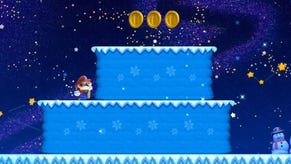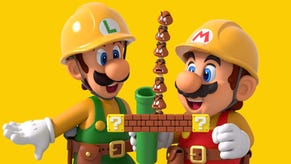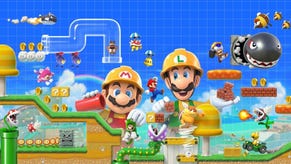Super Mario Maker Wii U Review: Infinite Fundiscovery
There's never been a more "Nintendo" creation than this 2D Mario construction kit.
This article first appeared on USgamer, a partner publication of VG247. Some content, such as this article, has been migrated to VG247 for posterity after USgamer's closure - but it has not been edited or further vetted by the VG247 team.
Super Mario Maker begins, unlike any other Nintendo game I can think of, in medias res. You basically skip the title screen and go immediately to playing, controlling Mario, without the need to tab through any credit screens or other speedbumps to the action.
It's a fitting evolution of the original Super Mario Bros., whose original title display hovered over the opening screen of World 1-1. Let it sit idle for a few moments and a demo would begin, and the seemingly decorative Mario standing at the lower left of the title screen would scurry forth and begin working his way through the first few obstacles of the first stage. Press Start and, after a quick flash to the black status screen that kept tally of your current progress and remaining lives, you'd begin controlling Mario from the exact same spot he occupied on the title screen.

It was always a neat little detail of the game, a far cry from the dissociated title screens previous NES releases, one that really hammered home the idea that Mario was about to embark on adventure, and that this game was truly something special.
Super Mario Maker's introduction doesn't simply exist as a throwback to the 30-year-old that inspired it, though; it also recreates the spirit of learning through play that helped establish SMB as one of the all-time greats. Super Mario's World 1-1 remains probably the most imitated, duplicated, and studied video game levels ever created, and for good reason. It eased players into the action, presenting in very clear terms the elements that SMB used to create danger, power-ups, and basic mechanics like jumping. The time-release approach through which Super Mario Maker's toolset reveals itself to new players shows its creators making a conscious effort to introduce players to the possibilities of this software, but I didn't appreciate just how deliberate an approach Nintendo would be taking until I sat down to play Maker for the first time.
Again, you find yourself playing immediately, taking control of Mario with no preamble, guiding him through the opening trials of a simple course. But almost as soon as you get a feel for the action, it comes to an abrupt halt: Mario goes skidding to a stop at the edge of a precipice. A small dialogue window pops up to lament the fact that no one bothered to complete this level, then offers you the opportunity to put right Nintendo's failing.
And... that's basically it for the tutorial phase of one of the most complex games Nintendo has ever created. You still see pop-ups every now and again, mainly to announce the addition of new tools to your palette or to encourage you to make use of online features, but otherwise Super Mario Maker mostly leaves you alone as you put together your own courses. You can optionally choose to run through some sample courses to get a sense of what the various tools can do, but you're never told in explicit terms how a mine functions, which physics features are unique to each different visual set, or how you can turn a plain green Koopa Troopa into a flying, red, gigantic Koopa Paratroopa. Super Mario Maker is as much sandbox as toolbox, and it places a remarkable amount of faith in players to figure things out on their own.
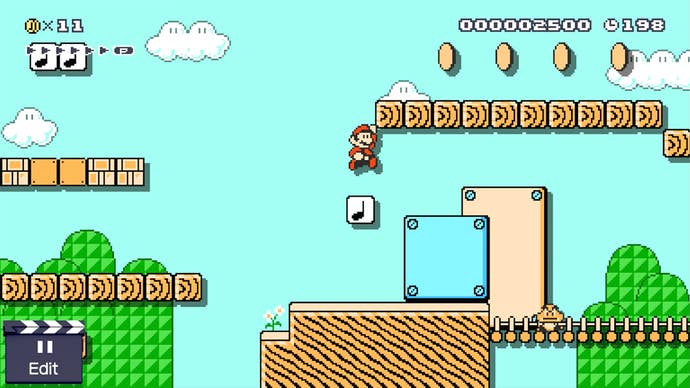
Then again, this low-key mentality to training is as much a sign of confidence in the design of the software as it is a symbol of faith in users. Nintendo can afford to take the hands-off approach when it's put together a tool kit as intuitive and simple to use as Super Mario Maker. The day-by-day tool unlocks help, to be sure, because you really need to figure out how to make functional stages with just basic bricks before you start fussing with conveyor belts. Yet even if you were jump right in to the full tool set (which many impatient types will do by fudging their system clock, though having been through the proper training cycle I really recommend taking the game at its own pace), Maker's interface and rules make it, by far, the easiest to use level creation tool ever sold to consumers.
Yes, you can find plenty of level-builder software that offers greater complexity and a wider array of options. Super Mario Maker lets you do a lot — a lot! — but it also has its share of glaring omissions. I can forgive the lack of Super Mario Bros. 2 features, because that game was so wildly different from any other Mario. But the lack of sloped surfaces? My apparent inability to change or otherwise control the direction of flying enemies so I can build elaborate jumping puzzles around them? No checkpoints? No partially submerged stages? No flipping between layers like in Super Mario World's fortresses? These oversights chafe, and they limit what you can reasonably accomplish with Maker's otherwise impressive suite of features.
I'm still happy to make that tradeoff, however, in exchange for such an intuitive and fuss-free interface. It's taken three years, but Nintendo has finally made a truly compelling, ironclad case for the existence of the Wii U's Game Pad. This software simply wouldn't be possible in its current form with its current capabilities on any other platform, much as I'd love to see it on 3DS. The size and resolution of the Game Pad screen provide enough space for fine control over the placement of game elements, and unlike a true tablet you can jump immediately between interface modality: Tap the Play/Edit button and you switch instantly from touch-screen layout management to classic controller play.
The ability to leap seamlessly between edit and play modes truly helps Super Mario Maker excel as a piece of design software. When you can tweak the placement of an object or enemy and immediately test it in action, you no longer have any excuses for poorly designed stages. It took me a few days to get past my impulse to try and create a full stage before testing it, as my multi-part public exercise in mastering Maker's learning curve will attest....
...but once you get the hang of it, you'll have a hard time going back to other level-making tools. I loved Mega Man Powered Up for PSP back in the day, but it's amateur hour compared to this.
Actually, I get the feeling Nintendo looked carefully at play patterns for games like Powered Up, because Super Mario Maker includes a few features that seem to function as direct responses to the bad habits that have bogged down other level tool kits. The most important of these: The need to be able to complete your own stage before you can inflict it on others. Maker allows you to upload your creations for others to play, either randomly as part of the 100 Mario Challenge, directly by using (sigh) a friend code, or from your profile page. Here's the rub, though: You yourself have to be able to play through your own work before you can post it to the servers. Having suffered through far too many literally impossible Powered Up stages, this simple little test makes a world of difference — it guarantees some degree of approachability, at least.
Even then, you can certainly expect Super Mario Maker to embody the principle of "you can lead a horse to water, but..." Simple as the software makes the act of creating Mario levels, it does nothing to guide you toward making good levels. The dozens upon dozens of new, premade stages included here do not, as you might hope, constitute a proper Mario "campaign." Rather, they serve more as demonstrations — quick, short examples to show off the potential of the tool set. Inspiring as that may be, it doesn't do much to help you lock down the necessities of making great levels. Enemy placement, block proportions, power-up locations, guiding players toward secrets, fair and reasonable challenges — these are fairly high-level concepts, and ultimately it's incumbent on you to sort out the particulars. Just as Super Mario Maker refuses to hold your hand to get you started, so too does it leave you to your own devices when it comes to making effective use of its potential.
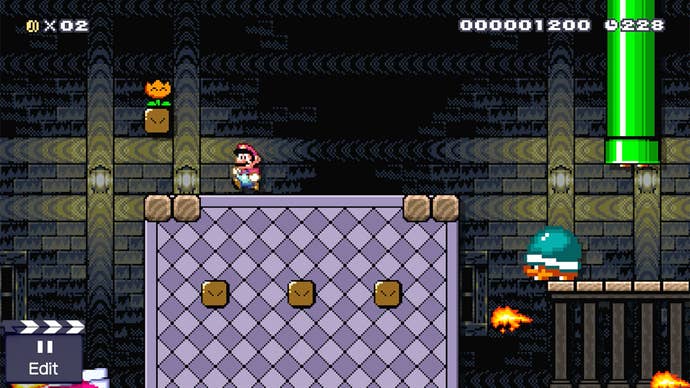
With the game yet to be released in any region, there's ultimately the question of how well Super Mario Maker will live up to its potential... or rather, how well the community will realize its potential. You can do incredible things with Super Mario Maker, but how many people will truly tap into the possibilities? How many insanely great, insanely creative stages will hit the public servers? If the current media trial period is anything to go by, you can expect the popular levels to be the ones that troll players or operate on an interesting gimmick... and novelty stages have their place, too. But I do hope that once the initial charm of literally being rickrolled wears thin, we'll see inventive masterpieces from future game designers making their way to the charts as well.
Even then, does it really matter if the servers are bogged down with silly gimmicks? The whole point of Super Mario Maker is that it puts near-total control in your hands... as long as you're having fun, it's doing its job. And I have a hard time imagining anyone not having fun with this brilliant piece of software that so adroitly blurs the line between game and game creation. I wouldn't mind seeing better and more robust sharing features, or a few additional design options, but ultimately these feel like minor quibbles. Nintendo has gone back to perhaps the most important game it ever created for an inspired new creation. Just as Super Mario Bros. redefined the platformer genre, Super Mario Maker redefines the idea of a consumer-level game design toolset. It makes complexity feel simple and creativity addictive, and it does so by drawing upon, and holding true to, the principles of accessibility and polish that made Super Mario Bros. such a landmark all those years ago.
InterfaceElegant and brilliant. Easy to use yet impressively flexible. The Wii U Game Pad's killer app (finally).
Lasting AppealEven if you burn out on creating stages, there'll inevitably be a near-infinite array of peer-built levels to play with.
SoundAs playful as anything else about the game. For example: When you place an object, a tiny voice sings the object's name in tune with the stage's background music.
VisualsAgain, simple but effective. But the amount of work invested into bringing latter-day Mario elements into the older games deserves special respect.
ConclusionWhat better way to commemorate three decades of Super Mario Bros. than to put the tools for creating Mario games in the hands of fans? The series has long since become a part of the medium's vocabulary, and Super Mario Maker turns the act of creating new Mario adventures into a process as intuitive as the play mechanics it reproduces. Whether you're a serious student of game design, looking to kill a few minutes with your friends' creations, or an avid enthusiast of sadism through game design, you'll find something to love in Super Mario Maker.




